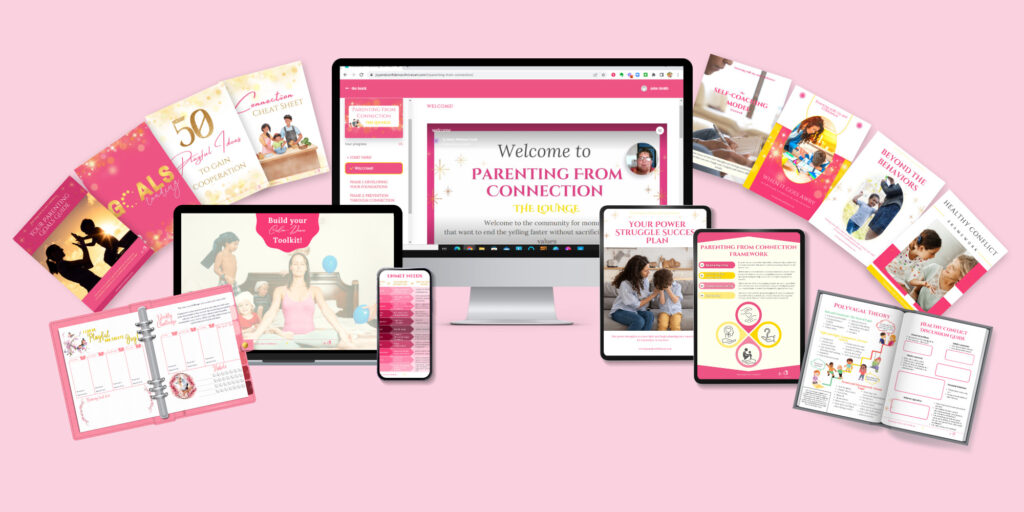4 Steps For Dealing With Challenging Behaviors
Dealing with challenging behaviors in children can be one of the trickiest aspects of parenting. I’ve been there myself, facing those moments when my child’s behavior left me scratching my head, wondering how to handle it. But over time, I’ve come to understand that addressing challenging behaviors requires a thoughtful approach that goes beyond immediate reactions. In this blog post, I’ll share insights and practical tips on understanding and managing challenging behaviors in children.
What Are Challenging Behaviors?
Challenging behaviors are actions or reactions in children that test our patience and parenting skills. They can take various forms, such as tantrums, aggression, defiance, or even withdrawal. Heck, even your kid spilling something after you said to be careful or calling their name and being annoyed can be a challenging behaviors. Sometimes they’re behaviors that we need to help our kids with and sometimes they’re behaviors that are only challenging because they trigger us and it’s something we, ourselves, need to overcome.
Why Understanding Challenging Behaviors Matters
Understanding challenging behaviors is the first step in addressing them effectively. When we grasp why our children act a certain way, we can respond in a way that helps rather than escalates the situation. So try to understand the root cause of those frustrating behaviors first. You can use my free 60 Second Sanity Savers to help you create a pause and calm yourself down so you have the mental and emotional space to dig deeper.
Step 1: Modeling Behavior and Knowing Your Why when dealing with frustrating behaviors
Modeling desired behaviors and knowing your “why” is like building the foundation for your children. It’s the most essential step because without modeling the behavior you want they don’t have anything to reference and it will confuse your child and lead to rebellion. You have to know that ‘this is the behavior that I want. This is the behavior that I’m really looking for, and that we value in our family, and this is why’. Because you can’t hold a boundary consistently and with respect if you don’t know why you’re doing it or you’re only doing it because ‘it’s just how it’s always been’.
Modeling Behavior: As parents, we are our children’s first role models. They watch and learn from our actions. So, if you want your child to exhibit certain behaviors, be sure to demonstrate them yourself. Whether it’s kindness, patience, or empathy, modeling these qualities helps your child understand what’s expected.
And it goes beyond even your actions to verbalizing your own thoughts! We have gone through actions and emotions so many times that we just naturally go through the motions needed. But our children don’t have the decades of experience you do. Depending on the age they may not even have conscious thoughts yet where they can plan things out internally. So we have to verbally go through our thought processes so our kids can understand and put the puzzle pieces together. The show True and the Rainbow Kingdom is great at this.
REMEMBER: You are creating your child’s inner voice. The one that will be with them affecting their decisions and actions even at 50! So be intentional!
Knowing Your Why: Understanding your motivations as a parent is crucial. Ask yourself why you want to address challenging behaviors. What values do you want to instill in your family? Having a clear “why” will guide your actions and decisions.
Action Step: Think through what behavior has frustrated you the most lately. Then ask yourself ‘why does this frustrate me so much? What do I want to have happen instead? Why is that important? Does it fit with our values or is it just expected?’
Step 2: Reflecting and Creating a Supportive Environment to Prevent Challenging Behaviors
Preventing challenging behaviors is stopping a problem before it starts. It’s meeting your child’s needs so they can meet your expectations. And it’s about recognizing triggers and setting the environment for success.
Identifying Triggers: Every child’s challenging behaviors have triggers. It could be fatigue, hunger, frustration, or even a specific situation. Recognizing these triggers is the first step in preventing challenging behaviors.
Setting Up a Supportive Environment: Once you’ve identified triggers, create an environment that supports positive actions. Minimize triggers when possible, and provide alternatives. For example, if your child acts out when tired, ensure they get enough rest. If you have a screentime expectation like no screens after a certain time, then make sure the environment is not set up to tempt them.
Action Step: Think about the frustrating behavior and reflect on what triggers may have been present but missed or ignored. How can you set them up for success next time?
Step 3: Empathy, Validation, and Building Connection
Empathy, validation, and building connection are like the glue that holds it all together. They create a foundation of trust and understanding that allows a child to feel safe enough to regulate their emotions and find solutions.
Empathy: Put yourself in your child’s shoes. Understand their perspective and feelings. This doesn’t mean agreeing with their behavior; it’s about showing that you care and can relate to their emotions. So if your child just hit their sister because sister just took his toy, it doesn’t matter that hitting is not ok at this moment. It’s about helping them understand that they felt violated to have something stolen. It’s getting on their level acknowledging that you understand those feelings.
Validation: Validate your child’s feelings. Let them know that what they feel is okay and you completely understand the urge to hurt someone after they hurt you. It doesn’t mean you condone negative behavior, but you understand the motivation and know that they’re still learning how to not act on those feelings and thoughts… that they are completely normal human beings and NOT bad kids.
Building Connection: A strong emotional connection with your child is key. It helps them feel safe and understood, making it easier to address challenging behaviors together. So connect before you correct. Take time to ease the waves of emotions. Help them feel loved and safe so those defenses will fall and their hearts and their brains will be ready to learn new methods.
Action Step: Now that you know your child’s trigger event, think through what you would say next time. How would you empathize, validate, and connect. Essentially how would you be responsive vs reactive?
Step 4: Discipline Techniques and Effective Teaching Methods for helping kids learn better behaviors
Discipline and teaching are the final building blocks. It’s about guiding your child toward better choices in the future. It’s saying “hey we all make mistakes, what do you want to do differently in the future?” Or even, “Hey, I see this is a struggle, how can I help?”
Discipline: Discipline doesn’t mean to punish. In fact, it’s original meaning was ‘to teach/ to guide’. It’s not about making your child feel shame for what they did but equipping them with the skills to make better choices in the future… over time…
Effective Teaching Methods: Teaching alternatives to challenging behaviors is important, but most humans aren’t going to learn best via a lecture (something I still have to remind myself because I like to talk problems to death). Role-playing, discussions, books, and creative activities can help your child understand and adopt positive actions in a way that best fits their brains.
Action Step: What is the lesson? How do they learn best?
Managing challenging behaviors in children is an ongoing journey. By understanding these behaviors, modeling desired actions, preventing triggers, empathizing, and using effective teaching methods, you can create a nurturing environment that supports your child’s development. Remember, it’s about guiding them towards becoming their best selves, not a mini version of you…
Understanding and managing challenging behaviors is a crucial part of parenthood. It’s a journey filled with learning experiences, and with patience and empathy, you can help your child navigate this path with confidence and grace.
When you’re ready to dive deeper and you want full access to the Power Struggle Success Plan, a community that supports and doesn’t judge, individualized coaching, and so much more, then check out the Parenting From Connection Community! Starting at just $7/m you can completely transform your home and feel confident in your actions!
Click below to learn more now!







